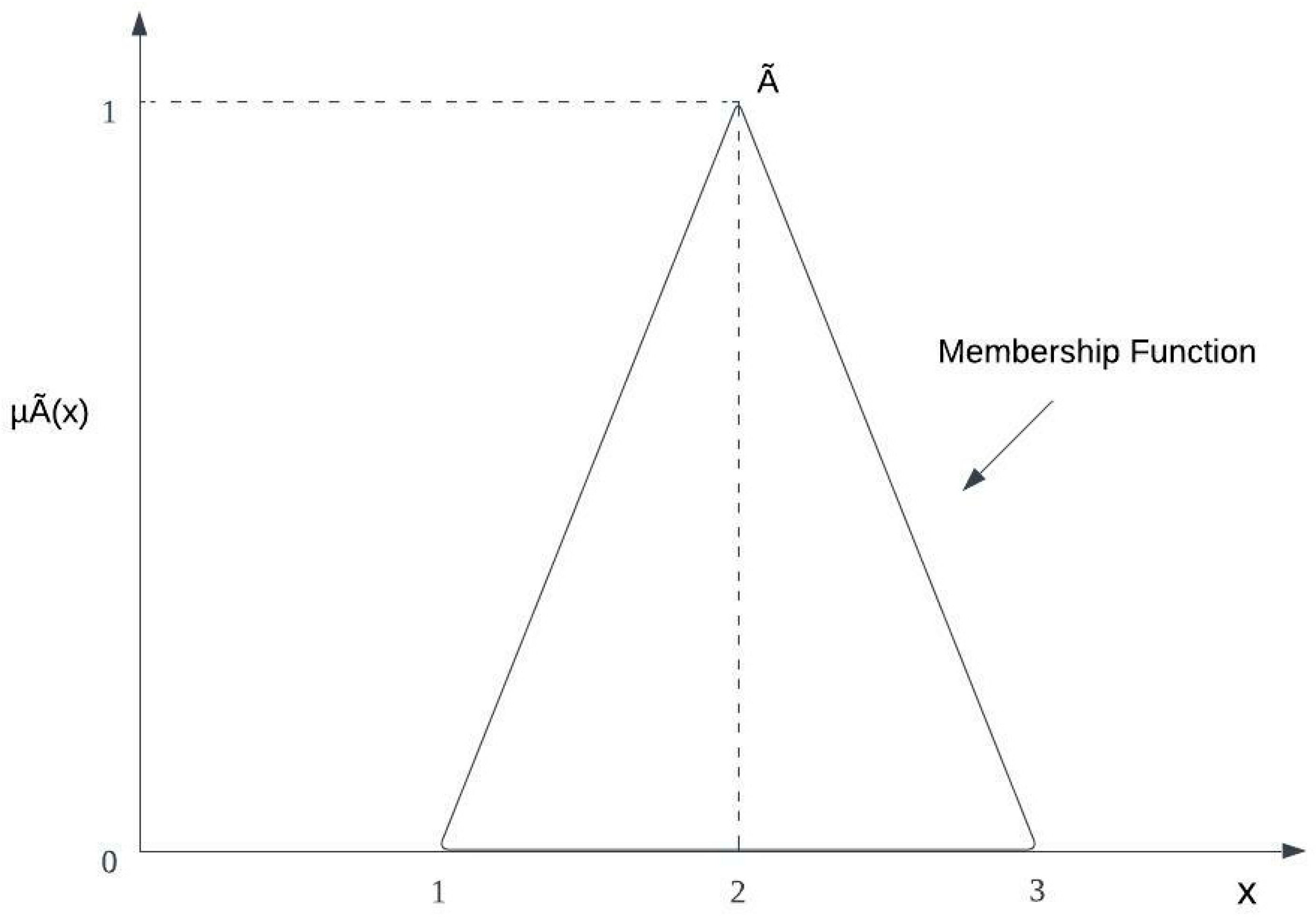A Mixed Reality-Based Platform towards Human-Cyber-Physical Systems with IoT Wearable Device for Occupational Safety and Health Training
Abstract
1. Introduction
1.1. Wearable Hand Device
1.2. Mixed Reality
1.3. Occupational Safety and Health Training
1.4. Problem Description and Objectives
- How could an MR-based environment be assisted for OSH training?
- How could HCPS be adopted for OSH training under an MR-based environment?
2. Theoretical Background and Related Works
2.1. IoT-Based Occupational Safety and Health
2.2. CPS-Based Occupational Safety and Health
2.3. Types of Hand Wearable Device
Hand Wearable Devices Related to Safety and Health
2.4. Research Gap
3. System Architecture and Methodology
3.1. Human–Cyber–Physical System
3.2. Wearable Hand Device
3.3. Multi-Criteria Decision Making (MCDM)
Fuzzy Analytic Hierarchy Process (FAHP)
4. Results and Discussion
4.1. Programming
4.2. Experiments
- ○
- Wear the glove and perform three finger positions: flat, 90-degree bends, and 180-degree bends. Record the raw readings of these three positions.
- ○
- Analyze the raw readings and interpret them into angles logically.
- ○
- Develop a program to perform the interpretation using the logic developed.
5. Concluding Remarks
Author Contributions
Funding
Institutional Review Board Statement
Informed Consent Statement
Data Availability Statement
Conflicts of Interest
References
- Croatti, A. Augmented Worlds: A proposal for modelling and engineering pervasive mixed reality smart environments. Ph.D. Thesis, University of Bologna, Bologna, Italy, 2019. [Google Scholar]
- Greer, C.; Burns, M.; Wollman, D.; Griffor, E. Cyber-Physical Systems and Internet of Things; National Institute of Standards and Technology (NIST): Gaithersburg, MD, USA, 2019.
- Abdul-Qawy, A.S.; Pramod, P.; Magesh, E.; Srinivasulu, T. The internet of things (iot): An overview. Int. J. Eng. Res. Appl. 2015, 5, 71–82. [Google Scholar]
- Din, I.U.; Guizani, M.; Hassan, S.; Kim, B.-S.; Khan, M.K.; Atiquzzaman, M.; Ahmed, S.H. The Internet of Things: A review of enabled technologies and future challenges. IEEE Access 2018, 7, 7606–7640. [Google Scholar] [CrossRef]
- Tai, L.; Liu, M. Mobile robots exploration through cnn-based reinforcement learning. Robot. Biomim. 2016, 3, 24. [Google Scholar] [CrossRef]
- Hua, J.; Li, Y.; Liu, C.; Wang, L. A zero-shot prediction method based on causal inference under non-stationary manufacturing environments for complex manufacturing systems. Robot. Comput. -Integr. Manuf. 2022, 77, 102356. [Google Scholar] [CrossRef]
- Liu, Z.; Liu, Q.; Xu, W.; Wang, L.; Zhou, Z. Robot learning towards smart robotic manufacturing: A review. Robot. Comput. -Integr. Manuf. 2022, 77, 102360. [Google Scholar] [CrossRef]
- Yang, C.; Wang, Y.; Lan, S.; Wang, L.; Shen, W.; Huang, G.Q. Cloud-edge-device collaboration mechanisms of deep learning models for smart robots in mass personalization. Robot. Comput. -Integr. Manuf. 2022, 77, 102351. [Google Scholar] [CrossRef]
- Nikolakis, N.; Senington, R.; Sipsas, K.; Syberfeldt, A.; Makris, S. On a containerized approach for the dynamic planning and control of a cyber-physical production system. Robot. Comput. -Integr. Manuf. 2020, 64, 101919. [Google Scholar] [CrossRef]
- Krishnamurthi, R.; Kumar, A.; Gopinathan, D.; Nayyar, A.; Qureshi, B. An overview of IoT sensor data processing, fusion, and analysis techniques. Sensors 2020, 20, 6076. [Google Scholar] [CrossRef]
- Keung, K.L.; Lee, C.K.M.; Ji, P.; Huo, J. Cloud-based Cyber-Physical Robotic Mobile Fulfillment Systems Considering Order Correlation Pattern. In Proceedings of the 2020 IEEE International Conference on Industrial Engineering and Engineering Management (IEEM), Singapore, 14–17 December 2020; pp. 113–117. [Google Scholar]
- Keung, K.L.; Lee, C.K.M.; Ji, P.; Ng, K.K.H. Cloud-based Cyber-Physical Robotic Mobile Fulfillment Systems: A Case Study of Collision Avoidance. IEEE Access 2020, 8, 89318–89336. [Google Scholar] [CrossRef]
- Keung, K.L.; Lee, C.K.M.; Ji, P. Data-driven order correlation pattern and storage location assignment in robotic mobile fulfillment and process automation system. Adv. Eng. Inform. 2021, 50, 101369. [Google Scholar] [CrossRef]
- Keung, K.L.; Chan, Y.Y.; Ng, K.K.H.; Mak, S.L.; Li, C.H.; Qin, Y.; Yu, C.W. Edge intelligence and agnostic robotic paradigm in resource synchronisation and sharing in flexible robotic and facility control system. Adv. Eng. Inform. 2022, 52, 101530. [Google Scholar] [CrossRef]
- Huo, J.; Keung, K.L.; Lee, C.K.M.; Ng, H.Y. Hand Gesture Recognition with Augmented Reality and Leap Motion Controller. In Proceedings of the 2021 IEEE International Conference on Industrial Engineering and Engineering Management (IEEM), Singapore, 13–16 December 2021; pp. 1015–1019. [Google Scholar]
- Keung, K.L.; Lee, C.K.M.; Ji, P. Industrial internet of things-driven storage location assignment and order picking in a resource synchronization and sharing-based robotic mobile fulfillment system. Adv. Eng. Inform. 2022, 52, 101540. [Google Scholar] [CrossRef]
- Xia, L.; Zheng, P.; Huang, X.; Liu, C. A novel hypergraph convolution network-based approach for predicting the material removal rate in chemical mechanical planarization. J. Intell. Manuf. 2021, 33, 2295–2306. [Google Scholar] [CrossRef]
- Zhang, X.; Zheng, P.; Peng, T.; He, Q.; Lee, C.K.M.; Tang, R. Promoting employee health in smart office: A survey. Adv. Eng. Inform. 2022, 51, 101518. [Google Scholar] [CrossRef]
- Xia, L.; Zheng, P.; Li, X.; Gao, R.X.; Wang, L. Toward cognitive predictive maintenance: A survey of graph-based approaches. J. Manuf. Syst. 2022, 64, 107–120. [Google Scholar] [CrossRef]
- Zheng, P.; Xia, L.; Li, C.; Li, X.; Liu, B. Towards Self-X cognitive manufacturing network: An industrial knowledge graph-based multi-agent reinforcement learning approach. J. Manuf. Syst. 2021, 61, 16–26. [Google Scholar] [CrossRef]
- Andersen, J.H.; Malmros, P.; Ebbehoej, N.E.; Flachs, E.M.; Bengtsen, E.; Bonde, J.P. Systematic literature review on the effects of occupational safety and health (OSH) interventions at the workplace. Scand. J. Work Environ. Health 2019, 45, 103–113. [Google Scholar] [CrossRef]
- Feng, W.; Qin, Y.; Zhao, S.; Feng, D. AAoT: Lightweight attestation and authentication of low-resource things in IoT and CPS. Comput. Netw. 2018, 134, 167–182. [Google Scholar] [CrossRef]
- Shih, C.; Chou, J.; Reijers, N.; Kuo, T. Designing CPS/IoT applications for smart buildings and cities. IET Cyber-Phys. Syst. Theory Appl. 2016, 1, 3–12. [Google Scholar] [CrossRef]
- Abera, T.; Asokan, N.; Davi, L.; Koushanfar, F.; Paverd, A.; Sadeghi, A.; Tsudik, G. Invited: Things, trouble, trust: On building trust in IoT systems. In Proceedings of the 2016 53nd ACM/EDAC/IEEE Design Automation Conference (DAC), Austin, TX, USA, 5–9 June 2016; pp. 1–6. [Google Scholar]
- Sadeghi, A.; Wachsmann, C.; Waidner, M. Security and privacy challenges in industrial Internet of Things. In Proceedings of the 2015 52nd ACM/EDAC/IEEE Design Automation Conference (DAC), San Francisco, CA, USA, 8–12 June 2015; pp. 1–6. [Google Scholar]
- Wang, L.; Törngren, M.; Onori, M. Current status and advancement of cyber-physical systems in manufacturing. J. Manuf. Syst. 2015, 37, 517–527. [Google Scholar] [CrossRef]
- Lee, J.; Bagheri, B.; Kao, H.-A. A Cyber-Physical Systems architecture for Industry 4.0-based manufacturing systems. Manuf. Lett. 2015, 3, 18–23. [Google Scholar] [CrossRef]
- Lee, J.; Kao, H.-A.; Yang, S. Service Innovation and Smart Analytics for Industry 4.0 and Big Data Environment. Procedia CIRP 2014, 16, 3–8. [Google Scholar] [CrossRef]
- Pasqualetti, F.; Dörfler, F.; Bullo, F. Attack Detection and Identification in Cyber-Physical Systems. IEEE Trans. Autom. Control 2013, 58, 2715–2729. [Google Scholar] [CrossRef]
- Mo, Y.; Kim, T.H.; Brancik, K.; Dickinson, D.; Lee, H.; Perrig, A.; Sinopoli, B. Cyber–Physical Security of a Smart Grid Infrastructure. Proc. IEEE 2012, 100, 195–209. [Google Scholar] [CrossRef]
- Rajkumar, R.; Lee, I.; Sha, L.; Stankovic, J. Cyber-physical systems: The next computing revolution. In Proceedings of the 47th Design Automation Conference, Anaheim, CA, USA, 13–18 June 2010; pp. 731–736. [Google Scholar]
- Lee, E.A. Cyber Physical Systems: Design Challenges. In Proceedings of the 2008 11th IEEE International Symposium on Object and Component-Oriented Real-Time Distributed Computing (ISORC), Orlando, FL, USA, 5–7 May 2008; pp. 363–369. [Google Scholar]
- Burg, A.; Chattopadhyay, A.; Lam, K.-Y. Wireless communication and security issues for cyber–physical systems and the Internet-of-Things. Proc. IEEE 2017, 106, 38–60. [Google Scholar] [CrossRef]
- Jing, T.; Zheng, P.; Xia, L.; Liu, T. Transformer-based hierarchical latent space VAE for interpretable remaining useful life prediction. Adv. Eng. Inform. 2022, 54, 101781. [Google Scholar] [CrossRef]
- Lins, R.G.; de Araujo, P.R.M.; Corazzim, M. In-process machine vision monitoring of tool wear for Cyber-Physical Production Systems. Robot. Comput. Integr. Manuf. 2020, 61, 101859. [Google Scholar] [CrossRef]
- Kong, X.T.R.; Zhong, R.Y.; Zhao, Z.; Shao, S.; Li, M.; Lin, P.; Chen, Y.; Wu, W.; Shen, L.; Yu, Y.; et al. Cyber physical ecommerce logistics system: An implementation case in Hong Kong. Comput. Ind. Eng. 2020, 139, 106170. [Google Scholar] [CrossRef]
- Schulze, C.; Thiede, S.; Thiede, B.; Kurle, D.; Blume, S.; Herrmann, C. Cooling tower management in manufacturing companies: A cyber-physical system approach. J. Clean. Prod. 2019, 211, 428–441. [Google Scholar] [CrossRef]
- Ma, S.; Zhang, Y.; Lv, J.; Yang, H.; Wu, J. Energy-cyber-physical system enabled management for energy-intensive manufacturing industries. J. Clean. Prod. 2019, 226, 892–903. [Google Scholar] [CrossRef]
- Poudel, S.; Ni, Z.; Malla, N. Real-time cyber physical system testbed for power system security and control. Int. J. Electr. Power Energy Syst. 2017, 90, 124–133. [Google Scholar] [CrossRef]
- Zhong, R.Y.; Xu, X.; Klotz, E.; Newman, S.T. Intelligent Manufacturing in the Context of Industry 4.0: A Review. COMPEL Int. J. Comput. Math. Electr. Electron. Eng. 2017, 3, 616–630. [Google Scholar] [CrossRef]
- Liu, C.; Cao, S.; Tse, W.; Xu, X. Augmented Reality-assisted Intelligent Window for Cyber-Physical Machine Tools. J. Manuf. Syst. 2017, 44, 280–286. [Google Scholar] [CrossRef]
- Liu, C.; Su, Z.; Xu, X.; Lu, Y. Service-oriented industrial internet of things gateway for cloud manufacturing. Robot. Comput. -Integr. Manuf. 2022, 73, 102217. [Google Scholar] [CrossRef]
- Lu, Y.; Liu, C.; Wang, K.I.K.; Huang, H.; Xu, X. Digital Twin-driven smart manufacturing: Connotation, reference model, applications and research issues. Robot. Comput. -Integr. Manuf. 2020, 61, 101837. [Google Scholar] [CrossRef]
- Xu, X. From cloud computing to cloud manufacturing. Robot. Comput. -Integr. Manuf. 2012, 28, 75–86. [Google Scholar] [CrossRef]
- Lui, C.F.; Liu, Y.; Xie, M. A Supervised Bidirectional Long Short-Term Memory Network for Data-Driven Dynamic Soft Sensor Modeling. IEEE Trans. Instrum. Meas. 2022, 71, 1–13. [Google Scholar] [CrossRef]
- Li, T.; Cao, J.; Liang, J.; Zheng, J. Towards context-aware medical cyber-physical systems: Design methodology and a case study. Cyber-Phys. Syst. 2015, 1, 5–23. [Google Scholar] [CrossRef]
- Jin, X.; Haddad, W.M.; Hayakawa, T. An adaptive control architecture for cyber-physical system security in the face of sensor and actuator attacks and exogenous stochastic disturbances. Cyber-Phys. Syst. 2018, 4, 39–56. [Google Scholar] [CrossRef]
- Chen, G.; Sabato, Z.; Kong, Z. Formal interpretation of cyber-physical system performance with temporal logic. Cyber-Phys. Syst. 2018, 4, 175–203. [Google Scholar] [CrossRef]
- DeSmit, Z.; Kulkarni, A.U.; Wernz, C. Enhancing cyber-physical security in manufacturing through game-theoretic analysis. Cyber-Phys. Syst. 2018, 4, 232–259. [Google Scholar] [CrossRef]
- Laszka, A.; Abbas, W.; Vorobeychik, Y.; Koutsoukos, X. Integrating redundancy, diversity, and hardening to improve security of industrial internet of things. Cyber-Phys. Syst. 2020, 6, 1–32. [Google Scholar] [CrossRef]
- Lydia, M.; Prem Kumar, G.E.; Selvakumar, A.I. Securing the cyber-physical system: A review. Cyber-Phys. Syst. 2022, 1–31. [Google Scholar] [CrossRef]
- Wang, Z.; Chen, C.-H.; Li, X.; Zheng, P.; Khoo, L.P. A context-aware concept evaluation approach based on user experiences for smart product-service systems design iteration. Adv. Eng. Inform. 2021, 50, 101394. [Google Scholar] [CrossRef]
- Wang, Z.; Chen, C.-H.; Zheng, P.; Li, X.; Khoo, L.P. A graph-based context-aware requirement elicitation approach in smart product-service systems. Int. J. Prod. Res. 2021, 59, 635–651. [Google Scholar] [CrossRef]
- Wang, Z.; Chen, C.-H.; Zheng, P.; Li, X.; Khoo, L.P. A novel data-driven graph-based requirement elicitation framework in the smart product-service system context. Adv. Eng. Inform. 2019, 42, 100983. [Google Scholar] [CrossRef]
- Li, C.H.; Chan, O.L.K.; Chow, Y.T.; Zhang, X.; Tong, P.S.; Li, S.P.; Ng, H.Y.; Keung, K.L. Evaluating the Effectiveness of Digital Content Marketing Under Mixed Reality Training Platform on the Online Purchase Intention. Front. Psychol. 2022, 13, 881019. [Google Scholar] [CrossRef]
- Chow, Y.T.; Li, C.H.; Mak, S.L.; Li, S.P.; Tong, P.S.; Fan, C.K.; Keung, K.L. How do full-service carriers and low-cost carriers passengers perceived service dimensions, passengers’ satisfaction, and loyalty differently? An empirical study. J. Ind. Eng. Manag. 2022, 15, 587–613. [Google Scholar] [CrossRef]
- Lang, S.; Dastagir Kota, M.S.S.; Weigert, D.; Behrendt, F. Mixed reality in production and logistics: Discussing the application potentials of Microsoft HoloLensTM. Procedia Comput. Sci. 2019, 149, 118–129. [Google Scholar] [CrossRef]
- Karlsson, A. Mixed Reality Displays in Warehouse Management: A study revealing new possibilities for Warehouse Management and Tangar. Master’s Thesis, KTH Royal Institute of Technology, Stockholm, Sweden, 2019. [Google Scholar]
- Flavián, C.; Ibáñez-Sánchez, S.; Orús, C. The impact of virtual, augmented and mixed reality technologies on the customer experience. J. Bus. Res. 2019, 100, 547–560. [Google Scholar] [CrossRef]
- Bekele, M.K.; Pierdicca, R.; Frontoni, E.; Malinverni, E.S.; Gain, J. A survey of augmented, virtual, and mixed reality for cultural heritage. J. Comput. Cult. Herit. (JOCCH) 2018, 11, 1–36. [Google Scholar] [CrossRef]
- Tepper, O.M.; Rudy, H.L.; Lefkowitz, A.; Weimer, K.A.; Marks, S.M.; Stern, C.S.; Garfein, E.S. Mixed reality with HoloLens: Where virtual reality meets augmented reality in the operating room. Plast. Reconstr. Surg. 2017, 140, 1066–1070. [Google Scholar] [CrossRef] [PubMed]
- Pan, Z.; Cheok, A.D.; Yang, H.; Zhu, J.; Shi, J. Virtual reality and mixed reality for virtual learning environments. Comput. Graph. 2006, 30, 20–28. [Google Scholar] [CrossRef]
- Hughes, C.E.; Stapleton, C.B.; Hughes, D.E.; Smith, E.M. Mixed reality in education, entertainment, and training. IEEE Comput. Graph. Appl. 2005, 25, 24–30. [Google Scholar] [CrossRef]
- Keung, K.L.; Lee, C.K.M.; Ng, K.K.H.; Yeung, C.K. Smart City Application and Analysis: Real-time Urban Drainage Monitoring by IoT Sensors: A Case Study of Hong Kong. In Proceedings of the 2018 IEEE International Conference on Industrial Engineering and Engineering Management (IEEM), Bangkok, Thailand, 16–19 December 2018; pp. 521–525. [Google Scholar]
- Chen, Q.; Cao, Y.-G.; Chow, W.-K. Comparison of legal system of occupational safety and health between Hong Kong and Mainland China. Open J. Saf. Sci. Technol. 2012, 2, 119–132. [Google Scholar] [CrossRef][Green Version]
- Lucchini, R.G.; London, L. Global occupational health: Current challenges and the need for urgent action. Ann. Glob. Health 2014, 80, 251–256. [Google Scholar] [CrossRef] [PubMed]
- Svertoka, E.; Saafi, S.; Rusu-Casandra, A.; Burget, R.; Marghescu, I.; Hosek, J.; Ometov, A. Wearables for industrial work safety: A survey. Sensors 2021, 21, 3844. [Google Scholar] [CrossRef] [PubMed]
- Holte, K.A.; Kjestveit, K. Young workers in the construction industry and initial OSH-training when entering work life. Work 2012, 41, 4137–4141. [Google Scholar] [CrossRef] [PubMed]
- Zheng, P.; Lin, T.-J.; Chen, C.-H.; Xu, X. A systematic design approach for service innovation of smart product-service systems. J. Clean. Prod. 2018, 201, 657–667. [Google Scholar] [CrossRef]
- Zheng, P.; Wang, H.; Sang, Z.; Zhong, R.Y.; Liu, Y.; Liu, C.; Mubarok, K.; Yu, S.; Xu, X. Smart manufacturing systems for Industry 4.0: Conceptual framework, scenarios, and future perspectives. Front. Mech. Eng. 2018, 13, 137–150. [Google Scholar] [CrossRef]
- Zheng, P.; Xu, X.; Chen, C.-H. A data-driven cyber-physical approach for personalised smart, connected product co-development in a cloud-based environment. J. Intell. Manuf. 2020, 31, 3–18. [Google Scholar] [CrossRef]
- Lopez, M.A.; Terron, S.; Lombardo, J.; Gonzalez-Crespo, R. Towards a Solution to Create, Test and Publish Mixed Reality Experiences for Occupational Safety and Health Learning: Training-MR. Int. J. Interact. Multimed. Artif. Intell. 2021, 7, 212. [Google Scholar] [CrossRef]
- Zheng, P.; Li, S.; Xia, L.; Wang, L.; Nassehi, A. A visual reasoning-based approach for mutual-cognitive human-robot collaboration. CIRP Ann. 2022, 71, 377–380. [Google Scholar] [CrossRef]
- Wu, F.; Wu, T.; Yuce, M.R. An internet-of-things (IoT) network system for connected safety and health monitoring applications. Sensors 2018, 19, 21. [Google Scholar] [CrossRef]
- Häikiö, J.; Kallio, J.; Mäkelä, S.-M.; Keränen, J. IoT-based safety monitoring from the perspective of construction site workers. Int. J. Occup. Environ. Saf. 2020, 4, 1–14. [Google Scholar] [CrossRef]
- Li, S.; Zheng, P.; Zheng, L. An AR-Assisted Deep Learning-Based Approach for Automatic Inspection of Aviation Connectors. IEEE Trans. Ind. Inform. 2021, 17, 1721–1731. [Google Scholar] [CrossRef]
- Liu, C.; Xu, X. Cyber-physical Machine Tool—The Era of Machine Tool 4.0. Procedia CIRP 2017, 63, 70–75. [Google Scholar] [CrossRef]
- Liu, C.; Vengayil, H.; Lu, Y.; Xu, X. A Cyber-Physical Machine Tools Platform using OPC UA and MTConnect. J. Manuf. Syst. 2019, 51, 61–74. [Google Scholar] [CrossRef]
- Liu, C.; Zheng, P.; Xu, X. Digitalisation and servitisation of machine tools in the era of Industry 4.0: A review. Int. J. Prod. Res. 2021, 59, 1–33. [Google Scholar] [CrossRef]
- Liu, B.; Zhang, Y.; Zhang, G.; Zheng, P. Edge-cloud orchestration driven industrial smart product-service systems solution design based on CPS and IIoT. Adv. Eng. Inform. 2019, 42, 100984. [Google Scholar] [CrossRef]
- Yiu, C.Y.; Ng, K.K.H.; Li, X.; Zhang, X.; Li, Q.; Lam, H.S.; Chong, M.H. Towards safe and collaborative aerodrome operations: Assessing shared situational awareness for adverse weather detection with EEG-enabled Bayesian neural networks. Adv. Eng. Inform. 2022, 53, 101698. [Google Scholar] [CrossRef]
- Zhang, X.; Ye, H.; Peng, T.; Peng, Y.; Tang, R.; Xiang, X. A Smart User Authentication Approach using Sensing Seat. In Proceedings of the 2020 IEEE 16th International Conference on Automation Science and Engineering (CASE), Hong Kong, China, 20–21 August 2020; pp. 317–322. [Google Scholar]
- Bu, L.; Chen, C.-H.; Zhang, G.; Liu, B.; Dong, G.; Yuan, X. A hybrid intelligence approach for sustainable service innovation of smart and connected product: A case study. Adv. Eng. Inform. 2020, 46, 101163. [Google Scholar] [CrossRef]
- Li, S.; Zheng, P.; Fan, J.; Wang, L. Towards Proactive Human Robot Collaborative Assembly: A Multimodal Transfer Learning-Enabled Action Prediction Approach. IEEE Trans. Ind. Electron. 2021, 69, 8579–8588. [Google Scholar] [CrossRef]
- Li, S.; Wang, R.; Zheng, P.; Wang, L. Towards proactive human–robot collaboration: A foreseeable cognitive manufacturing paradigm. J. Manuf. Syst. 2021, 60, 547–552. [Google Scholar] [CrossRef]
- Li, S.; Fan, J.; Zheng, P.; Wang, L. Transfer Learning-enabled Action Recognition for Human-robot Collaborative Assembly. Procedia CIRP 2021, 104, 1795–1800. [Google Scholar] [CrossRef]
- Fan, J.; Zheng, P.; Li, S. Vision-based holistic scene understanding towards proactive human–robot collaboration. Robot. Comput. Integr. Manuf. 2022, 75, 102304. [Google Scholar] [CrossRef]
- Stojadinovic, S.M.; Majstorovic, V.D.; Durakbasa, N.M. Toward a cyber-physical manufacturing metrology model for industry 4.0. Artif. Intell. Eng. Des. Anal. Manuf. 2021, 35, 20–36. [Google Scholar] [CrossRef]
- Horváth, I.; Zeng, Y.; Liu, Y.; Summers, J. Smart designing of smart systems. Artif. Intell. Eng. Des. Anal. Manuf. 2021, 35, 129–131. [Google Scholar] [CrossRef]
- Horváth, I. Connectors of smart design and smart systems. Artif. Intell. Eng. Des. Anal. Manuf. 2021, 35, 132–150. [Google Scholar] [CrossRef]
- Boursinos, D.; Koutsoukos, X. Assurance monitoring of learning-enabled cyber-physical systems using inductive conformal prediction based on distance learning. Artif. Intell. Eng. Des. Anal. Manuf. 2021, 35, 251–264. [Google Scholar] [CrossRef]
- Ghosh, A.K.; Ullah, A.M.M.S.; Kubo, A. Hidden Markov model-based digital twin construction for futuristic manufacturing systems. Artif. Intell. Eng. Des. Anal. Manuf. 2019, 33, 317–331. [Google Scholar] [CrossRef]
- Podgorski, D.; Majchrzycka, K.; Dąbrowska, A.; Gralewicz, G.; Okrasa, M. Towards a conceptual framework of OSH risk management in smart working environments based on smart PPE, ambient intelligence and the Internet of Things technologies. Int. J. Occup. Saf. Ergon. 2017, 23, 1–20. [Google Scholar] [CrossRef] [PubMed]
- Liang, X.; Ghannam, R.; Heidari, H. Wrist-worn gesture sensing with wearable intelligence. IEEE Sens. J. 2018, 19, 1082–1090. [Google Scholar] [CrossRef]
- Kumar, P.; Verma, J.; Prasad, S. Hand data glove: A wearable real-time device for human-computer interaction. Int. J. Adv. Sci. Technol. 2012, 43, 15–26. [Google Scholar]
- Sayeed, S.; Kamel, N.S.; Besar, R. Virtual reality based dynamic signature verification using data glove. In Proceedings of the 2007 International Conference on Intelligent and Advanced Systems, Kuala Lumpur, Malaysia, 25–28 November 2007; pp. 1260–1264. [Google Scholar]
- Choudhury, S.; Singh, R.; Shobhana, A.; Sen, D.; Anand, S.S.; Shubham, S.; Gangopadhyay, S.; Baker, M.R.; Kumar, H.; Baker, S.N. A novel wearable device for motor recovery of hand function in chronic stroke survivors. Neurorehab. Neural Repair 2020, 34, 600–608. [Google Scholar] [CrossRef]
- Park, S.; Fraser, M.; Weber, L.M.; Meeker, C.; Bishop, L.; Geller, D.; Stein, J.; Ciocarlie, M. User-driven functional movement training with a wearable hand robot after stroke. IEEE Trans. Neural Syst. Rehab. Eng. 2020, 28, 2265–2275. [Google Scholar] [CrossRef]
- Mardonova, M.; Choi, Y. Review of wearable device technology and its applications to the mining industry. Energies 2018, 11, 547. [Google Scholar] [CrossRef]
- Choi, B.; Hwang, S.; Lee, S. What drives construction workers’ acceptance of wearable technologies in the workplace?: Indoor localization and wearable health devices for occupational safety and health. Autom. Constr. 2017, 84, 31–41. [Google Scholar] [CrossRef]
- Liu, Z.; Wang, J. Human-cyber-physical systems: Concepts, challenges, and research opportunities. Front. Inf. Technol. Electron. Eng. 2020, 21, 1535–1553. [Google Scholar] [CrossRef]
- Wang, B.; Zhou, H.; Yang, G.; Li, X.; Yang, H. Human Digital Twin (HDT) Driven Human-Cyber-Physical Systems: Key Technologies and Applications. Chin. J. Mech. Eng. 2022, 35, 1–6. [Google Scholar] [CrossRef]
- Patel, V.; Chesmore, A.; Legner, C.M.; Pandey, S. Trends in Workplace Wearable Technologies and Connected-Worker Solutions for Next-Generation Occupational Safety, Health, and Productivity. Adv. Intell. Syst. 2022, 4, 2100099. [Google Scholar] [CrossRef]
- Chen, X.; Gong, L.; Wei, L.; Yeh, S.C.; Xu, L.D.; Zheng, L.; Zou, Z. A Wearable Hand Rehabilitation System With Soft Gloves. IEEE Trans. Ind. Inform. 2021, 17, 943–952. [Google Scholar] [CrossRef]
- Cerro, I.; Latasa, I.; Guerra, C.; Pagola, P.; Bujanda, B.; Astrain, J.J. Smart System with Artificial Intelligence for Sensory Gloves. Sensors 2021, 21, 1849. [Google Scholar] [CrossRef]
- Chang, D.-Y. Applications of the extent analysis method on fuzzy AHP. Eur. J. Oper. Res. 1996, 95, 649–655. [Google Scholar] [CrossRef]
- Leung, L.C.; Cao, D. On consistency and ranking of alternatives in fuzzy AHP. Eur. J. Oper. Res. 2000, 124, 102–113. [Google Scholar] [CrossRef]
- Wang, Y.-M.; Luo, Y.; Hua, Z. On the extent analysis method for fuzzy AHP and its applications. Eur. J. Oper. Res. 2008, 186, 735–747. [Google Scholar] [CrossRef]
- Liu, Y.; Eckert, C.M.; Earl, C. A review of fuzzy AHP methods for decision-making with subjective judgements. Expert Syst. Appl. 2020, 161, 113738. [Google Scholar] [CrossRef]
- Kumar, R.D.; Nagarajan, V. Implementation and Performance Measure of Fuzzy AHP for Resource Allocation in 5G. Fluct. Noise Lett. 2021, 20, 2150020. [Google Scholar] [CrossRef]
- Mathew, M.; Chakrabortty, R.K.; Ryan, M.J. A novel approach integrating AHP and TOPSIS under spherical fuzzy sets for advanced manufacturing system selection. Eng. Appl. Artif. Intell. 2020, 96, 103988. [Google Scholar] [CrossRef]
- Zheng, X.; Chen, H.; Xue, S.; Zheng, C.; Qi, F. Study on explosion risk assessment of low-concentration gas safe combustion system based on FAHP-fuzzy fault tree. Qual. Reliab. Eng. Int. 2022, 38, 484–500. [Google Scholar] [CrossRef]
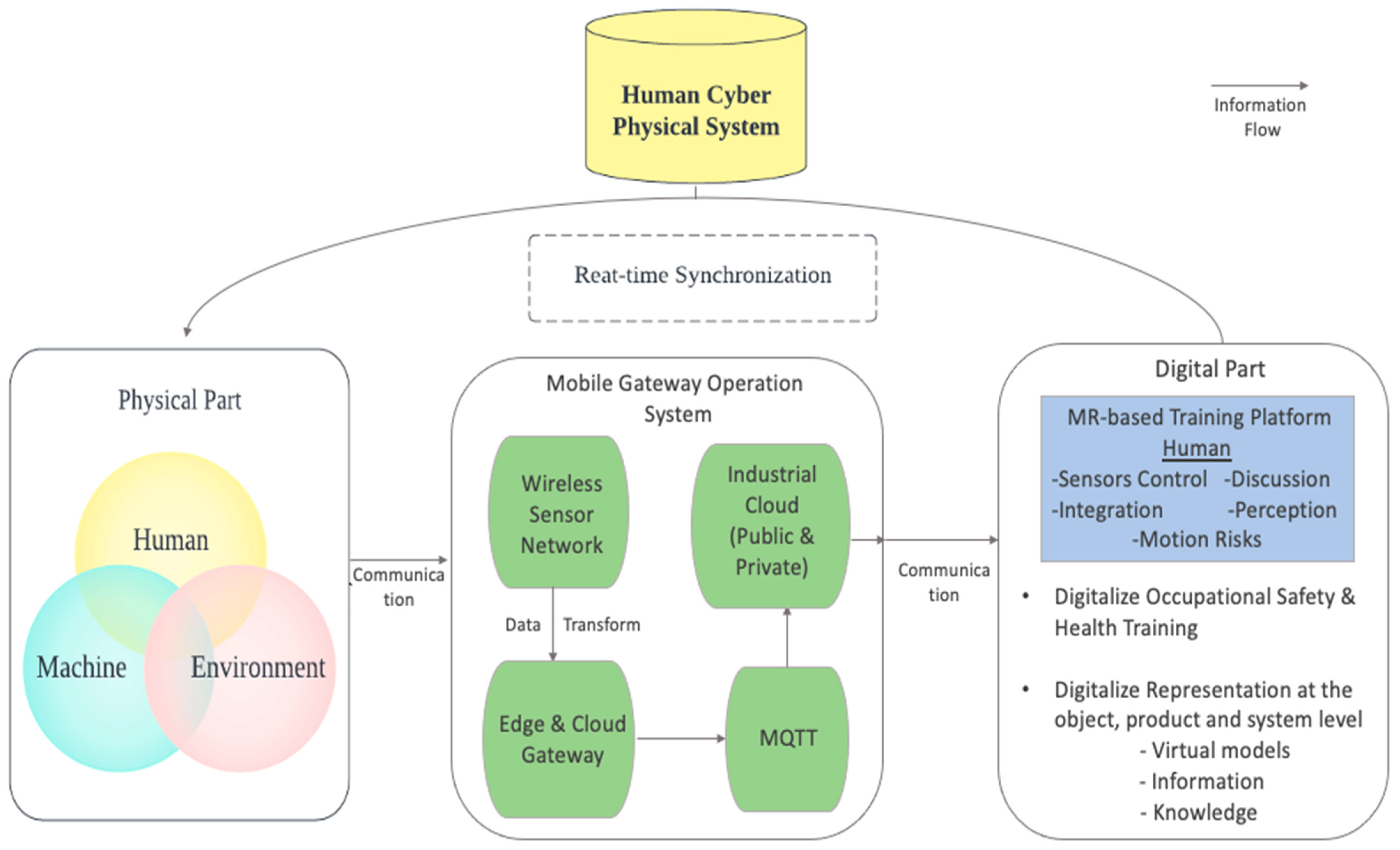
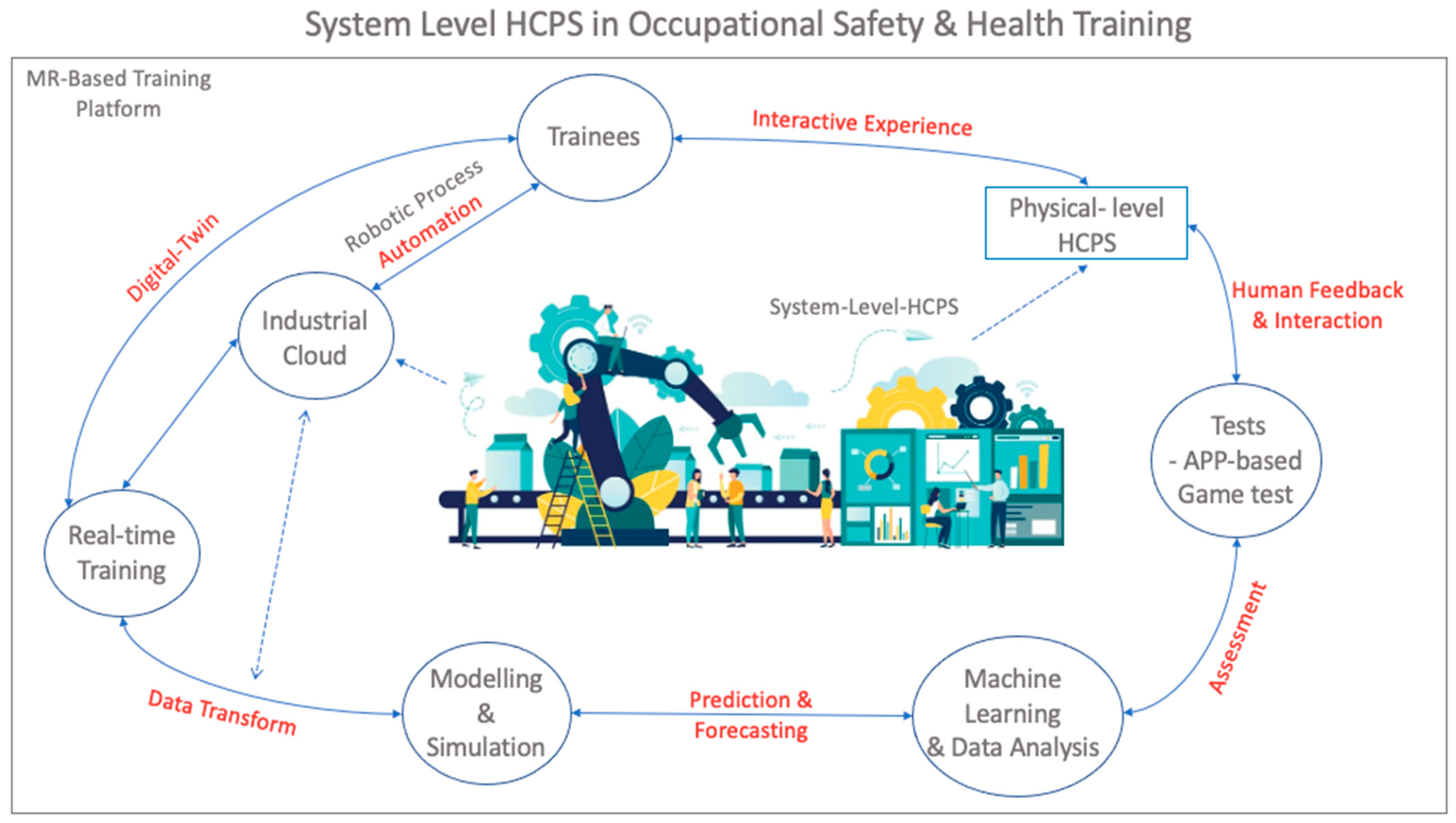
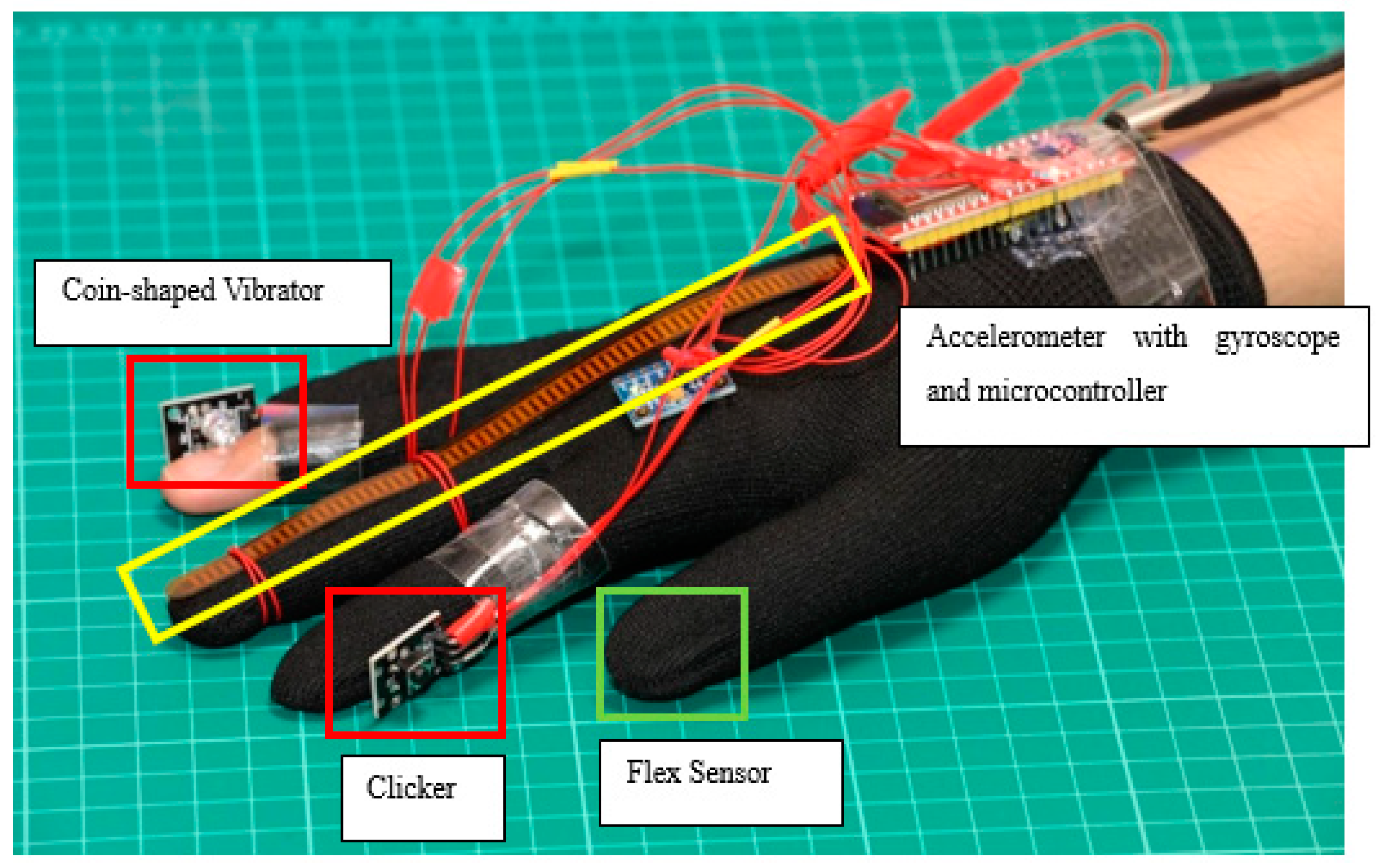
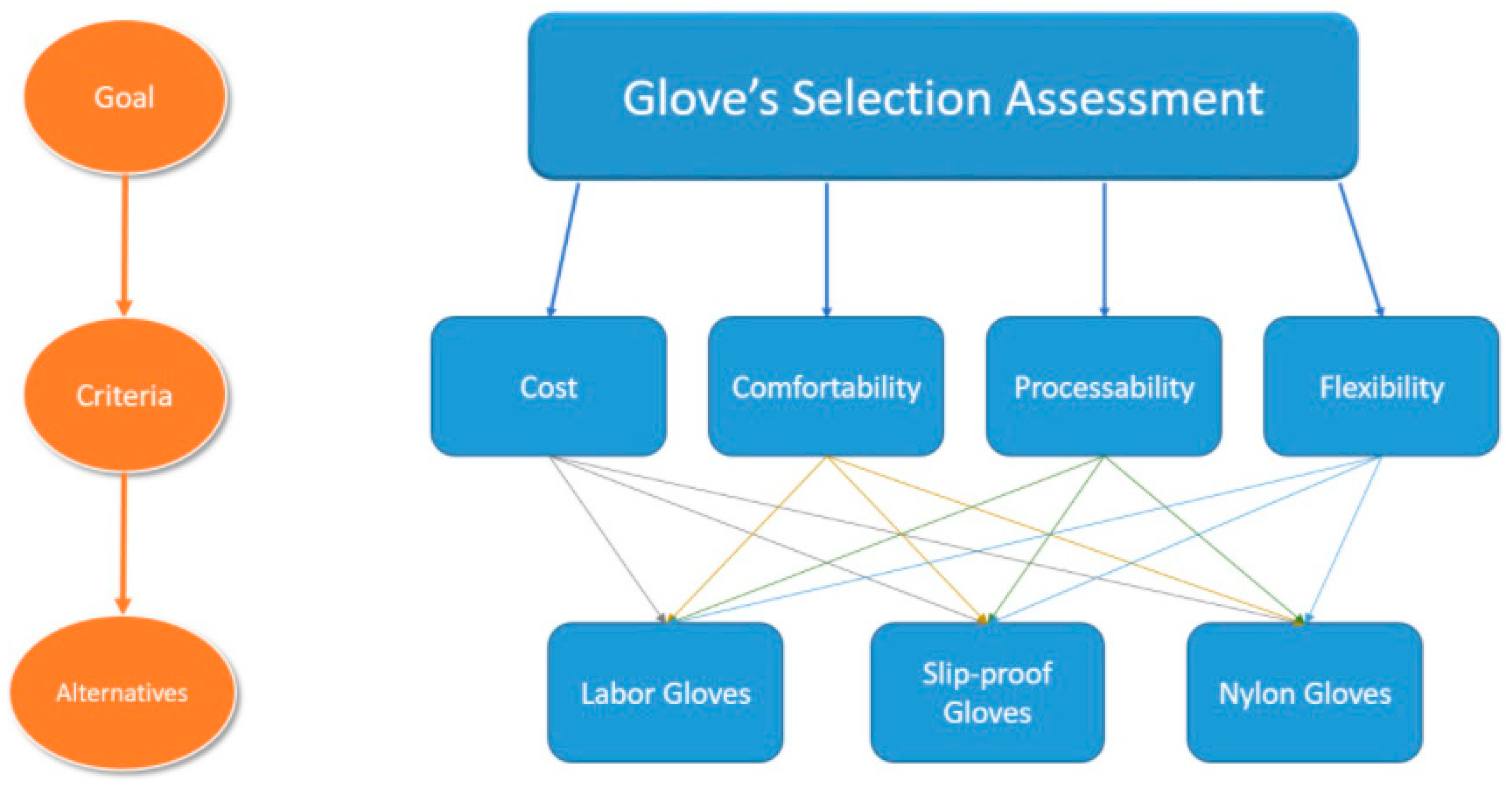

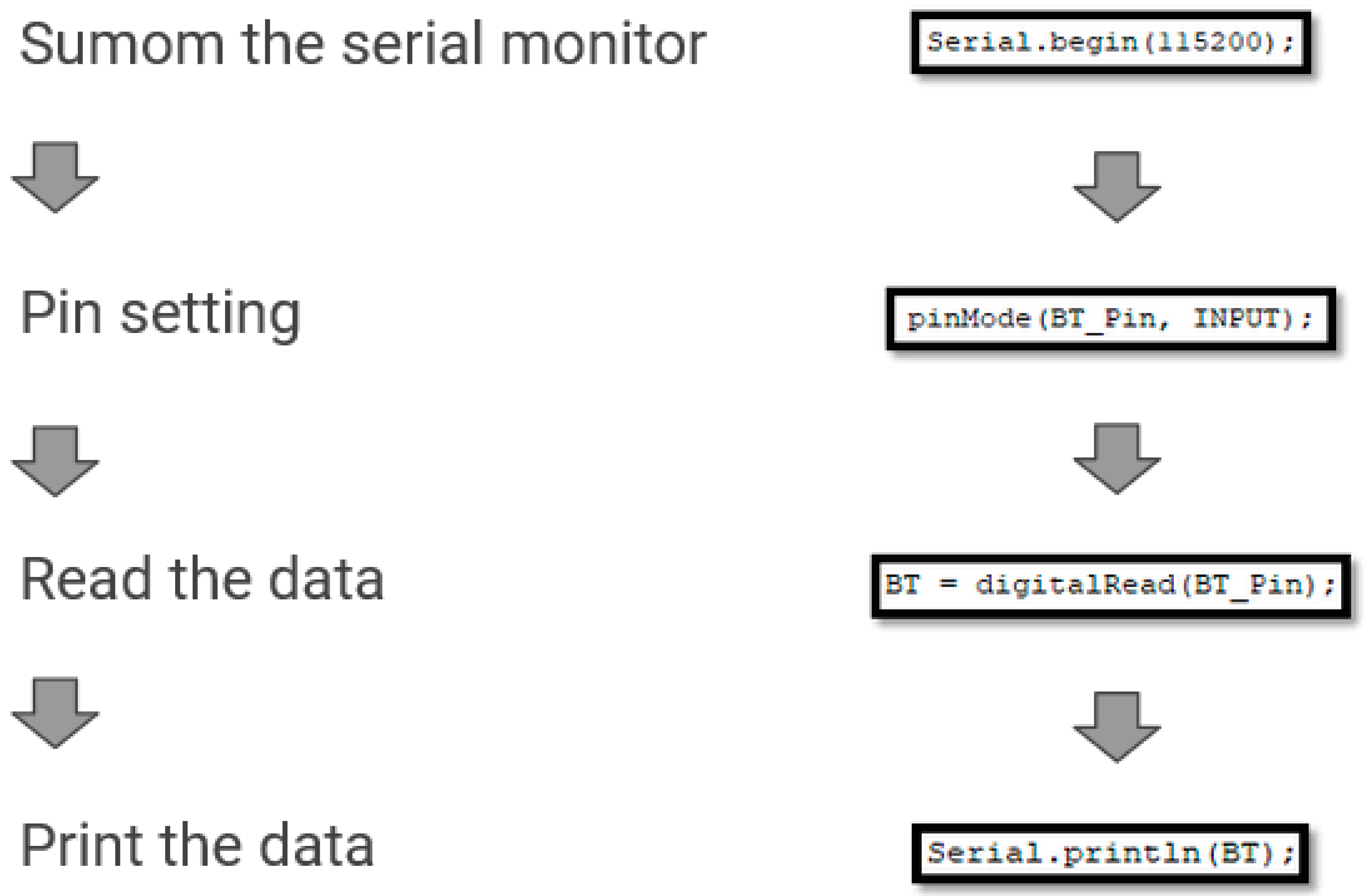
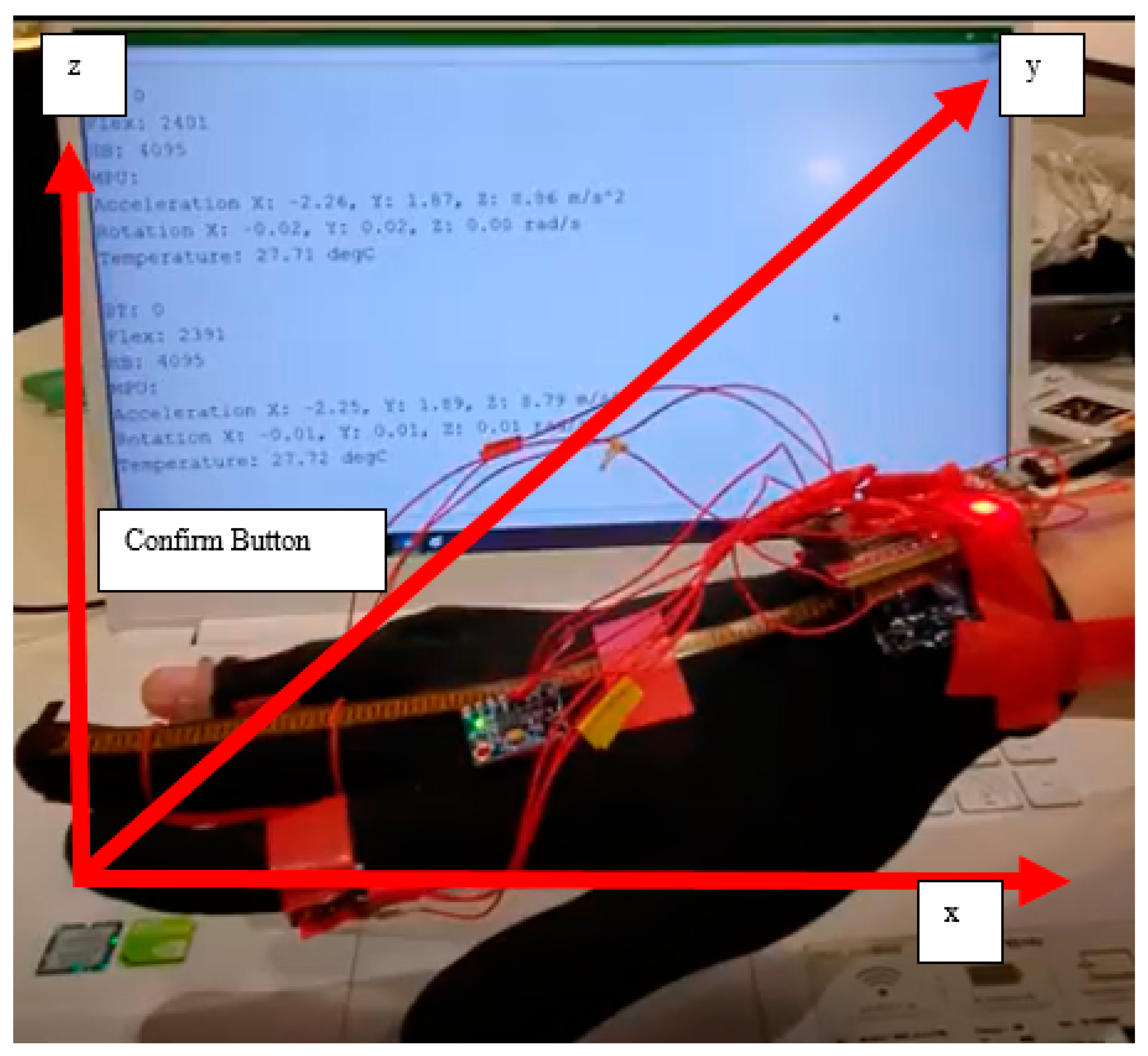
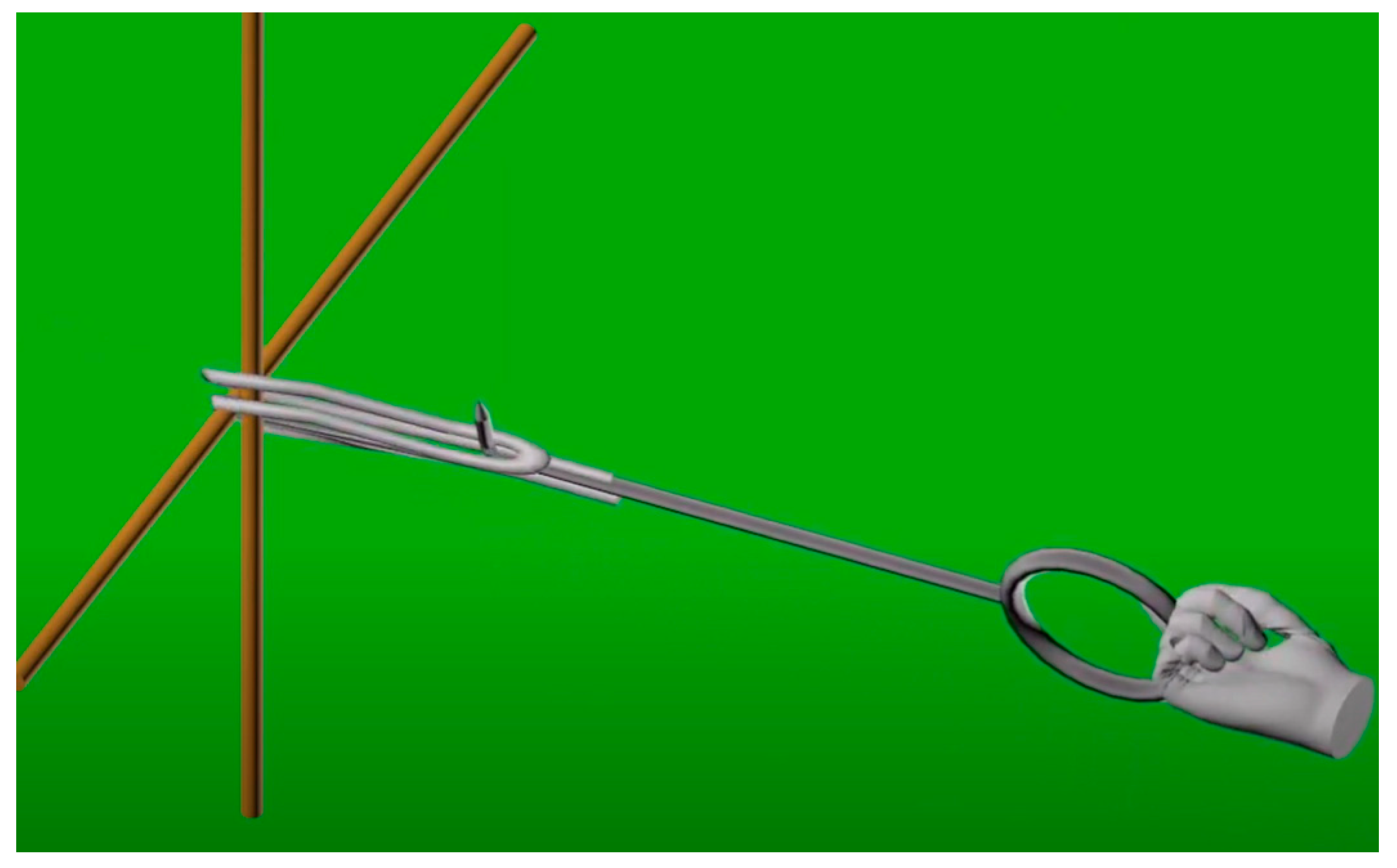
| Gender | Average Length | Average Breadth |
|---|---|---|
| Male | 18.9 cm | 8.4 cm |
| Female | 17.2 cm | 7.4 cm |
| Sensor Type | Usage | Relationship with Project |
|---|---|---|
| Temperature sensors |
| Track trainer’s skin temperature |
| Position sensors |
| Track the movement of fingers, such as bending |
| Motion sensors [104] |
| Track trainer’s gesture during work (formal gesture or not) |
| Force sensors [104] |
| Track trainer’s applied force to the glove |
| Accelerometer with gyroscope [105] |
| Track the position of the whole hand |
| Cost | Comfortability | Processability | Flexibility | |
|---|---|---|---|---|
| Cost | 1 | 5 | 4 | 7 |
| Comfortability | 1 | 3 | ||
| Processability | 2 | 1 | 3 | |
| Flexibility | 1 |
| 1 | 2 | 3 | 4 | |
|---|---|---|---|---|
| Attribute or criteria | Cost | Comfortability | Processability | Flexibility |
| Numeric Value | Fuzzy Number | |
|---|---|---|
| Equal | 1 | (1,1,1) |
| Moderate | 3 | (2,3,4) |
| Strong | 5 | (4,5,6) |
| Very strong | 7 | (6,7,8) |
| Extremely strong | 9 | (9,9,9) |
| Intermediate values | 2 | (1,2,3) |
| 4 | (3,4,5) | |
| 6 | (5,6,7) | |
| 8 | (7,8,9) |
| Price or Cost | Storage Space | Camera | Looks | |
|---|---|---|---|---|
| Cost | 1 | 5 | 4 | 7 |
| Comfortability | 1 | 3 | ||
| Processability | 2 | 1 | 3 | |
| Flexibility | 1 | |||
| Price or cost | Storage Space | Camera | Looks | |
| Cost | (1,1,1) | (4,5,6) | (3,4,5) | (6,7,8) |
| Comfortability | (1,1,1) | (2,3,4) | ||
| Processability | (1,2,3) | (1,1,1) | (2,3,4) | |
| Flexibility | (1,1,1) |
| Price or Cost | Storage Space | Camera | Looks | The Fuzzy Geometric Mean Value | Fuzzy Weights | |
|---|---|---|---|---|---|---|
| Cost | (1,1,1) | (4,5,6) | (3,4,5) | (6,7,8) | (2.91, 3.44, 3.94) | (0.428, 0.610, 0.859) |
| Comfortability | () | (1,1,1) | () | (2,3,4) | (0.58, 0.74, 1) | (0.085, 0.131, 0.218) |
| Processability | () | (1,2,3) | (1,1,1) | (2,3,4) | (0.80, 1.11, 1.41) | (0.117, 0.196, 0.309) |
| Flexibility | () | () | () | (1,1,1) | (0.30, 0.35, 0.45) | (0.044, 0.063, 0.099) |
| Fuzzy Weights | Weights wi | |
|---|---|---|
| Cost | (0.428, 0.610, 0.859) | 0.633 |
| Comfortability | (0.085, 0.131, 0.218) | 0.145 |
| Processability | (0.117, 0.196, 0.309) | 0.207 |
| Flexibility | (0.044, 0.063, 0.099) | 0.068 |
| Weights wi | Normalized weights | |
| Cost | 0.633 | = 0.601 |
| Comfortability | 0.145 | = 0.138 |
| Processability | 0.207 | = 0.197 |
| Flexibility | 0.068 | = 0.065 |
| Total | 0.633 + 0.145 + 0.207 + 0.068 = 1.058 | 0.601 + 0.138 + 0.197 + 0.065 = 1 |
| Linguistic Terms | Spherical Fuzzy Number |
|---|---|
| Extremely low | [0.045, 0.955 0.045] |
| Very low | [0.135, 0.865 0.135] |
| Low | [0.255, 0.745 0.255] |
| Fair | [0.335, 0.665 0.335] |
| Medium | [0.410, 0.590 0.410] |
| Good | [0.500, 0.500 0.500] |
| Very good | [0.590, 0.410 0.410] |
| High | [0.665, 0.335 0.335] |
| Very high | [0.745, 0.255 0.255] |
| Exceptionally high | [0.865, 0.135 0.135] |
| Excellent | [0.955, 0.045 0.045] |
| Finger Angle (FA) | Raw Reading Boundary |
|---|---|
| 0-degree | less than 1500 |
| 90-degree | less than 3500 |
| 180-degree | less than 4000 |
| 1 | //Flex Loop |
| 2 | int Flex = analogRead(Flex_Pin); |
| 3 | //Serial.print(“Flex: “); |
| 4 | //Serial.println(Flex); |
| 5 | int FA = 0; |
| 6 | if (Flex ≤ 1500){ |
| 7 | FA = 0;} |
| 8 | else if (Flex ≤ 3500){ |
| 9 | FA = (Flex − 1500)/(2000/90);} |
| 10 | else if (Flex ≤ 4000){ |
| 11 | FA = (Flex − 3500)/(500/90);} |
| 12 | else{ |
| 13 | FA = 180;} |
| 14 | Serial.print(“Flex: ”) |
| 15 | Serial.print(FA); |
| 16 | Serial.println(“ degree”); |
| Traditional | Mixed Reality Platform | |
|---|---|---|
| Accuracy | ||
| Acceleration and coordinate | 92.50% | 95.00% |
| Finger bending | 94.00% | 95.50% |
| Confirm button | 97.00% | 97.75% |
| Errors ratio | ||
| Acceleration and coordinate | 13.25% | 11.25% |
| Finger bending | 5.00% | 4.25% |
| Confirm Button | 0.25% | 0.20% |
| Processing time | ||
| Acceleration and Coordinate | 8.00 ± 3.0 s | 13.00 ± 5.0 s |
| Finger bending | 5.00 ± 2.0 s | 7.00 ± 2.5 s |
| Confirm Button | 2.00 ± 1.0 s | 2.50 ± 1.5 s |
Publisher’s Note: MDPI stays neutral with regard to jurisdictional claims in published maps and institutional affiliations. |
© 2022 by the authors. Licensee MDPI, Basel, Switzerland. This article is an open access article distributed under the terms and conditions of the Creative Commons Attribution (CC BY) license (https://creativecommons.org/licenses/by/4.0/).
Share and Cite
Li, C.H.J.; Liang, V.; Chow, Y.T.H.; Ng, H.-Y.; Li, S.-P. A Mixed Reality-Based Platform towards Human-Cyber-Physical Systems with IoT Wearable Device for Occupational Safety and Health Training. Appl. Sci. 2022, 12, 12009. https://doi.org/10.3390/app122312009
Li CHJ, Liang V, Chow YTH, Ng H-Y, Li S-P. A Mixed Reality-Based Platform towards Human-Cyber-Physical Systems with IoT Wearable Device for Occupational Safety and Health Training. Applied Sciences. 2022; 12(23):12009. https://doi.org/10.3390/app122312009
Chicago/Turabian StyleLi, Chi Ho Jimmy, Vincy Liang, Yuk Ting Hester Chow, Hiu-Yin Ng, and Shek-Ping Li. 2022. "A Mixed Reality-Based Platform towards Human-Cyber-Physical Systems with IoT Wearable Device for Occupational Safety and Health Training" Applied Sciences 12, no. 23: 12009. https://doi.org/10.3390/app122312009
APA StyleLi, C. H. J., Liang, V., Chow, Y. T. H., Ng, H.-Y., & Li, S.-P. (2022). A Mixed Reality-Based Platform towards Human-Cyber-Physical Systems with IoT Wearable Device for Occupational Safety and Health Training. Applied Sciences, 12(23), 12009. https://doi.org/10.3390/app122312009





